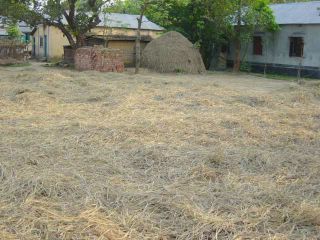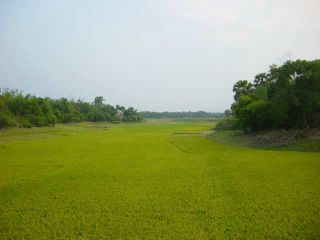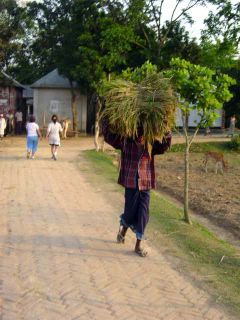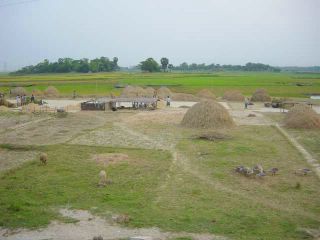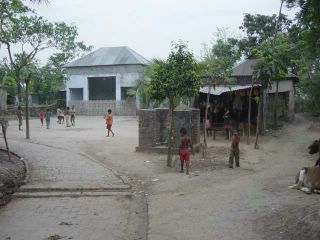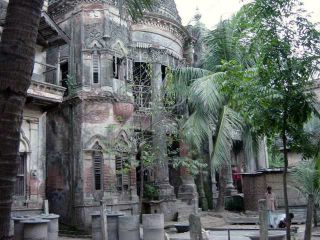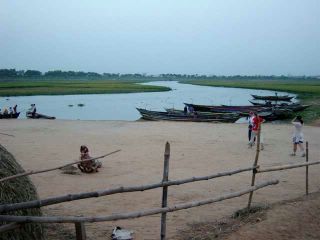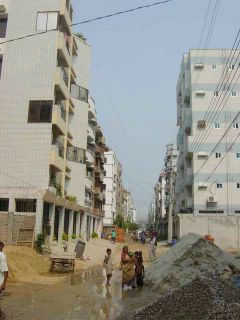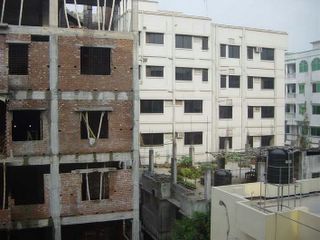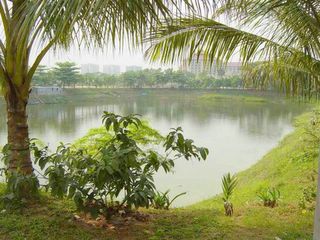Last Thursday and Friday were a “long weekend” in Bangladesh to celebrate Bangladesh New Year. I went on a trip to a place in West Bangladesh called Paksey. We left Dhaka about 8am on Thurs and drove three and a half hours to Paksey which is about 220km from Dhaka. The roads were mostly very good, but there were quite a few hair-raising incidents with buses and trucks. They don't give way to anything, quite happy to pass other traffic on blind corners. We had to pull off the road a couple of times to avoid a head on!!! I just have to put my trust in the driver and pray God's protection over us.
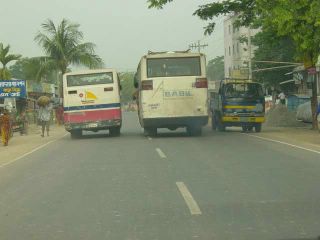
Reza, the office manager at Maunsell (the company I'm working for) had gone on ahead on Weds to make sure everything was OK for my arrival. Before Reza worked in the Maunsell office in Dhaka he was based at Paksey for 4 years as office manager for the consultants involved in the construction of a new bridge over the Padma (Ganges) river. He had responsibility for running the office and the little village compound that was constructed for the consultant team. The bridge construction was completed in May last year so all the consultant team has finished and gone. Reza put me up in the Project Manager's house on the compound. It was very nice, air conditioned and very comfortable. I had a cook laid on and Reza came and ate with me, plus on Thurs night we celebrated Bangladeshi New Year with Reza and some of his friends for dinner at the house I was in. He brought a bottle of French red wine and some beers. Any way I'm getting ahead of myself.
After lunch on Thurs Reza showed me around the area. First he showed me the project office for the bridge project. It was a big office and they had a big team there (it’s all empty now basically.) The Project Manager was a pommie guy, plus they had Australian and NZ engineers working on the project. Reza had a lot of responsibility looking after the big office, plus the accommodation compound plus transport plus other stuff as well. By all accounts he did a great job.
Then we drove across the new bridge to the other side of the river. The bridge is about 1.8km long. The river is almost that wide although there is relatively little water in it at the moment, compared to what it is like during the rainy season. Previously the only way across the river was by ferry. Just next to the new bridge is a railway bridge that was built by the British in 1912. It is a beautiful bridge in amazing condition for its age, all steel. It is prohibited to take photos of the old bridge or go up onto it but Reza is so well known he got permission for me to go up onto the rail bridge and walk across back to the other side of the river. I also took quite a few photographs, it’s a wonder I wasn't shot by the armed guards all over the place. The bridge got bombed from the air by Pakistan during independence wars, so maybe they don’t like photos taken in case they are used for planning further bombing attempts.
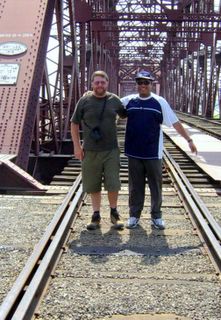
Me and Reza
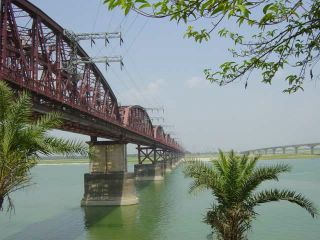
After the walk across the rail bridge Reza took me to the construction camp for the bridge and we sat and chatted to a couple of the Chinese engineers who worked on the new bridge. The bridge was built by Chinese contractors (Maunsell were involved in the design aspects of the bridge.) The poor Chinese guys were bored to tears as they were just waiting out what is called the defects liability period i.e. they have to stay there for a certain time after completion in case anything goes wrong. But because the bridge has been so well designed and built there's been nothing for them to do.
After this, Reza drove me around some of the local area of Paksey. Back at the beginning of the last century the British had colonised the area so you can still see a lot of the old British built buildings around the place, quite fascinating. We then went back and picked up 3 other guys and we drove up some really rough roads and tracks to a location up the river where they had installed some bank protection works to prevent erosion. There is a bend in the river a few km north of the bridges and they wanted to protect the bank at the bend so it didn't erode and get in behind the bridges further downstream. So I got to get right down to the river's edge and to dip my hands in the mighty Ganges River. It was quite an experience.
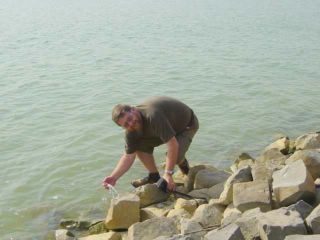
We then drove back down the river's edge to the bridges again. Reza had arranged for us to get access to the inside of the new bridge, so we climbed up into the first hollow bridge section and walked through to the first pier. The bridge is absolutely massive. It is supported by piers consisting of four 3 metre diameter piles that go down 90 metres through the sand to sit on a solid foundation. It’s quite a feat of civil engineering.

After this we drove a few k's and had a look at a lychee orchard. The lychees ripen in May/June so at the moment they are just little green things. We then went further out into the country to look for bee hives. One of Reza's friends has been experimenting with bee hives and getting honey that the bees have produced from the lychee flowers. We went to a little village way out in the wop wops where a guy had a couple of experimental small beehives just next to his house. He had two hives, one had native bees in it and the other had normal type bees like we have at home. He took the lid off both hives and pulled out a frame with the honeycomb on it, all without any protection at all. The bees were quite passive.
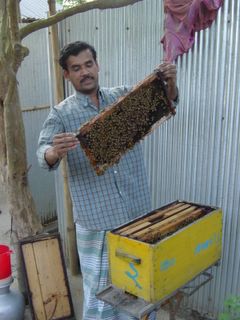
He then gave us a taste of some honey that he had collected previously. It was quite runny and clear looking but it tasted very sweet and with quite a tangy flavour. It almost made my throat sort of close up it was so intense. Quite different from the honey from the comb here. One of the engineers on the bridge project had helped them set this experiment up, and they may develop it with more hives so that they can extract the honey and sell it. We then drove back to the compound as the sun was setting.
After we had our evening meal and New Year celebration we went out and drove up onto the new bridge again to see what it looked like at night with all its lights on. We also had a look around one of the toll plazas (you pay toll to cross the bridge.) Reza is justifiably proud of the bridge and his involvement in it. So it was an incredibly full on day on Thursday. I was a tired boy by the end of it.
On Friday, Reza had some work to do finishing off stuff to do with the bridge project, so he sent me out with some of his friends to look at some of the local sites on the Western side of the bridge. We drove for about an hour way out into the wop wops again and ended at a palace that was owned by a world famous Bengali poet Rabindranath Tagore who died in 1941 (I'd never heard of him) see
http://nobelprize.org/literature/laureates/1913/tagore-bio.html The palace was built over 100 years ago and it’s got quite a few artifacts and old photos in it depicting this poet's life. He must have been up there with the elite because there are photos of him with Mahatma Gandhi and Indian PM Nehru.
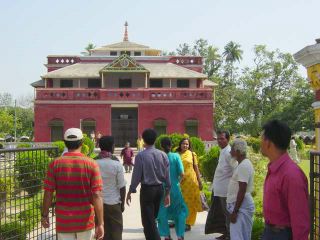
We walked around the grounds of the palace which are quite pleasant, and there was a blind guy with a young boy and another guy who played instruments and sang folk songs about the poet. I got to join in with them having a go on the tabla drums and playing a 1 stringed instrument that makes real Indian sounding music noises, so that was great fun. They didn’t ask me to join their band however.
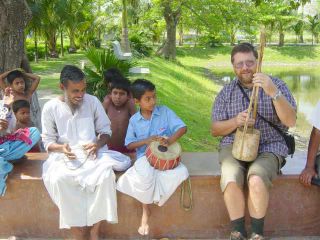
We then drove back to another place which was the burial place of another famous Bangladeshi, Lalon Shah (who again I had never heard of). They have an academy there for promoting and studying his music (Baul music they call it) and there was a group singing and playing wailing Indian type music. I didn't join in this time as it looked a lot more serious and formal. We passed through quite a sizeable town called Kushtia which you should be able to find on the map. Paksey is directly North of that, right on the river.
It is quite a few degrees hotter over there compared to Dhaka with the temperatures in the high 30s.
We drove back to the compound and I had a bit of a snooze before lunch as I was really tired. Then we drove back to Dhaka, Reza coming with us this time. The countryside is very flat with every square inch of land as far as the eye can see taken up with some sort of agricultural or food production, rice, sugar cane, tobacco, banana, papaya, mango plantations, coconut trees. It’s all quite green and beautiful but there is so much of it.
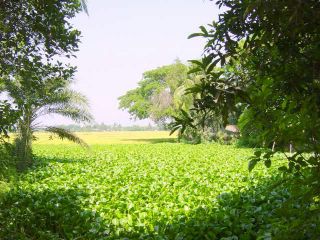
Because we were taking Reza back we took a slightly different route back into Dhaka city. We went past a place where a nine-story garment factory had collapsed last Sunday night while the night shift was working in it. So far they've retrieved 20 bodies and 70 people managed to get out but they are estimating there are about 100 more missing still trapped in the rubble. We saw the collapsed building from the road. It was just a heap of rubble about three stories high, just amazing. There were thousands and thousands of locals all around just watching the rescue efforts, and I guess relatives of people who worked there hoping for a miracle. It’s just awful. They don't have the proper equipment to deal with the situation so its going to take a while to clear it all up.
We continued on in to Dhaka and the traffic was just awful. So many traffic jams and holdups and close shaves with everybody pushing and shoving and taking risks with passing. I was so glad when we got back into the city proper and the roads ran a bit better.
So an event filled couple of days which enabled me to see quite a bit of the country and see some interesting sights, especially the bridges and the Ganges river. Everybody I met was very friendly and helpful. Reza was very pleased that I went and relished the opportunity to show me around. He wants me to go back during the mango and lychee season and also to see the area during the monsoon season when the river is in full flood. He said it is a very different place then. So I may go back there to have another look.

